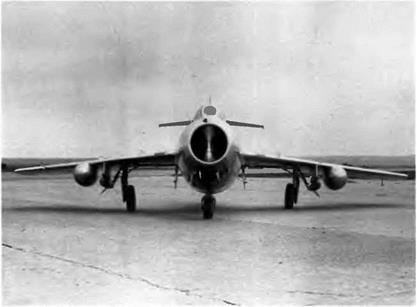MiG-15 bis Burlaki
Burlaki is a nickname that means "towed.” The purpose of this experimental prototype was to assess the feasibility of a rather odd idea. In the early 1950s, the Dalnyaya Aviatsiya (DA) or long-range bomber force still used Tu-4s because no jet bomber was yet available, and therefore it needed escort fighters. It was to meet this need that the Yakovlev ОКБ designed the Burlaki system for the MiG-15 bis.
|
This SD-21 has, in addition to its rockets, two 250-1 (66-US gallon) slipper tanks. |
A boom fitted with a hooking device (called a garpun or harpoon) and a steel wire was set in front of the engine air intake. The hook was sent outward by a pneumatic cylinder at the pilot’s order. When the bomber reached its flight level, the fighter closed in and lined up outside the bomber’s wake vortex. The fighter pilot then threw his harpoon toward the end of a cable trailing behind the Tu-4. Once the docking was made, the fighter pilot shut off the engine and was towed like a glider. In case of emergency the pilot could restart the engine and separate from the bomber. He could engage enemy aircraft and return to dock once more, a procedure that could be repeated several times.
With the Burlaki system the range of an escort fighter could be almost doubled. In tests at the ОКБ and with a DA bomber unit, however, the system’s drawbacks quickly became evident. For example, once the engine was shut down the pressurization or heating systems cut out as well. At altitudes between 8,000 m (26,240 feet) and 10,000 m (32,800 feet) pilots could breathe through their oxygen masks, but few could withstand a long ride in an unpressurized and icy cockpit. This was enough to seal the fate of the system, and it is no wonder that the prototype was not certified. In any case, the Tu-4s were soon replaced by Tu-16 jet bombers.
|
The SD-57 was a production MiG-15 bis used for testing automatic 57-mm rocket pods, hence its designation |












